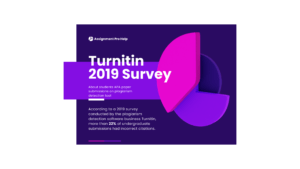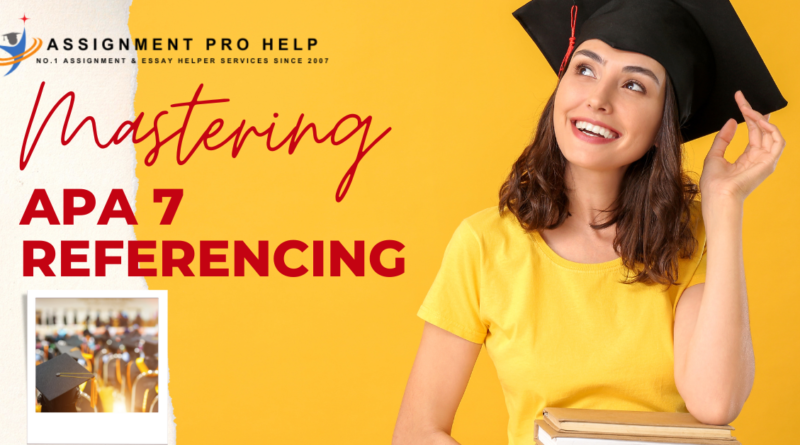Mastering APA 7 Referencing: Your Ultimate Guide to Perfect Citations
I. Introduction
Referencing is the important of academic writing, as it validates the work and makes it credible and academic. To be a premium player in the academic world, you must reference your work in a specific style depending on the teacher’s instructions. One common style you may come across is APA 7 referencing. This perfect guide will help you understand the rules of APA 7 referencing so you can have a accurate in-text citation and citation of your work and improve the quality of the documents. Mastering referencing as a student, researcher, and professional writer to be outstanding in your field of subject.
The following information demonstrates how important referencing is:

- According to a 2021 Journal of Educational Psychology study, students who correctly cited their sources showed a stronger knowledge of the subject than those who didn’t.
- According to a 2019 survey conducted by the plagiarism detection software business Turnitin, more than 22% of undergraduate submissions had incorrect citations.
By mastering APA 7 referencing, you can avoid these issues and establish yourself as a top performer in your subject.
II. Deep Dive into APA 7 Guidelines
APA 7 guidelines you with a framework to build clear and consistent citations in your academic writing. Let us explore its key elements:
Create in-text citations:
APA 7 requires you to take responsibility for citing your sources in your writing through in-text citations. They include the author’s last name and the publication year, e.g., (Lawton, 2020). If you are quoting a source, you will also need to include the page number, e.g., (Lawton, 2020, p. 45). Yet, it is worth mentioning the differences — book, article, and website will all be cited differently. Check the manual for the exact way to do it.
Build a Robust Reference List:
A separate page at the end of your academic paper for the reference list. This list provides detailed information about every source you cited within the text. Arrange the entries alphabetically by the author’s last name and include complete publication details like the title, publisher, and publication date. Each referencing should follow a proper format depending on the source type (journal article, online database, chapter, book, dissertation, webpage).
Master Formatting Rules:
APA 7 has specific formatting rules for your assignment layout, including margins, font size, and spacing. Double-spacing complete document with 1-inch margins on all sides. Choose a clear and easy-to-read font like Times New Roman or Arial, set font size of 12 points. Prepare your task with headings that follow a designated format based on their academic level.
By learning and using these guidelines, you will guarantee accurate, proper citations and in-text citations that adhere to APA 7 writing style. This, in turn, enhance the credibility and professionalism of your academic writing.
III. In-Text Citations Made Clear & Simple
Dear writers! As per APA 7, in-text citations act as a form of acknowledgment to the sources that give your academic assignment strength and credibility. This makes it easier for readers to find those sources’ full details in the list of references at the end of the task. The complete information on how to cite them correctly is as follows:
- Single Author: Put the year of publication and the author’s last name in brackets, e.g., (Balini, 2024).
- Quoting: If you are directly quoting, add the page number, example, (Balini, 2024, p. 38).
- Multiple Authors: For sources with two authors, include both names, e.g., (Benton & Lee, 2019). For three or more authors, use the first author’s name followed by “et al.,” e.g., (Balini et al., 2018).
- No Author: If a source has no author, use the title or a shortened version of the title, e.g., (“Study Finds,” 2023).
- Organization as Author: When an organization is the author, use the full name in the first citation and an abbreviation in subsequent citations, e.g., (World Health Organization [WHO], 2024).
- Multiple Works by the Same Author: Differentiate between works by the same author published in the same year by adding a lowercase letter after the year, e.g., (Balini, 2024a; Balini, 2024b).
- Electronic Sources: Include the author, year, and specific page or paragraph number for direct quotes, e.g., (Johnson, 2019, para. 3).
According to APA 7, in-text citations serve as tiny road signs for your writing. They direct your audience to the full list of references at the end of your article. Anyone who views your task will be able to quickly locate the sources you cited. To make it easy for readers to locate your sources, it’s essential to maintain these citations clear and consistent throughout your writing!
IV. Creating an Error-Free Reference List
The reference list is a vital component of APA 7 writing style, providing detailed information about the sources cited in your task. Here is how to create a perfect reference list:
- Simple Format: Start your reference list on a new page with the title “References” centered at the top. List all sources alphabetically by the author’s last name.
- Book References: Format book references with the author’s last name followed by initials, publication year in parentheses, title in italics, and publication information, e.g., Balini, J. (2024). The Art of Better Health.
Example- Buchbinder, S. B., & Shanks, N. H. (2012). Introduction to health care management. Jones and Bartlett Publishers.
- Journal Article References: Format journal article references with the author’s last name followed by initials, publication year in parentheses, article title, journal name in italics, volume number in italics, issue number in parentheses, page range, and DOI or URL if available, e.g., Johnson, A. (2019). Writing in APA Style. Journal of Writing, 5(2), 100-120. DOI: 10.1331/jowr.2019.005.
Example- Berg, J. M., Grant, A. M., & Johnson, V. (2010). When callings are calling: Crafting work and leisure in pursuit of unanswered occupational callings. Organization Science, 21(5), 973–994. https://doi.org/10.1287/orsc.1090.0497
- Website References: Format website references with the author’s last name followed by initials, publication or update date in parentheses, title of the webpage in italics, website name, and URL, e.g., Balini, J. (2024, May 5). APA Style Guide. Retrieved from www.apastyleguide.com.
Example- Kocagoncu, E., Klimovich-Gray, A., Hughes, L. E., & Rowe, J. B. (2021). Evidence and implications of abnormal predictive coding in dementia. Brain, 144(11), 3311–3321. https://doi.org/10.1093/brain/awab254
- Other Source Types: Follow similar formatting guidelines for other source types, such as blogs, reports, databases, conference papers, or online videos.
Example- Kapil Jain. (2024, April 26). Unraveling Brain Tumor Care: Causes, Diagnosis, and Management Options Explored. Max Healthcare. https://www.maxhealthcare.in/blogs/brain-tumors-causes-symptoms-and-diagnosis
Make sure that every reference is valid and appropriately formatted in accordance with APA 7 requirements. A well-written reference list gives your writing more authority and makes it easier for readers to find the sources you used for more research.
V. Tips for Perfecting Your APA 7 Referencing
Mastering APA 7 referencing takes lot of practice, but with these quick tips, you will be on your way to creating error-free citations:
Use Citation Management Web Tools: Websites like Citation Machine, Scribbr, or MyBib can help you manage your references and automatically generate APA 7 citations. Below are the links for the websites.
- Citation Machine – https://www.citationmachine.net/
- MyBib – https://www.mybib.com/#/
- Scribbr – https://www.scribbr.com/citation/generator/

- Check Your Citations: Make sure in-text citations and reference list match.
- Be Consistent: Use APA 7 guidelines for formatting, punctuation, and capitalization.
- Consult the APA Manual: Refer to the APA Publication Manual for clear guidelines.
- Proofread Your References: Avoid typos and errors in your references.
- Stay Updated: Keep up with APA rule changes.
- Practice, Practice, Practice: Practice makes perfect with APA 7 referencing.
By following these tips, you will be confident and accurate in your APA 7 referencing, improving the quality and credibility of your academic writing
VI. Tools to Simplify APA 7 Referencing
Using the right tools can streamline the APA 7 referencing process. Here are some helpful tools:
- Citation Management Software: Tools like Scribbr, MyBib, or Citation Machine can manage your references and generate APA 7 citations.
- Microsoft Word APA Style Templates: Microsoft Word offers templates that format your document according to APA 7 guidelines.
- APA Style Blog: The APA Style Blog provides updates and clarifications on APA 7 guidelines. Here you can catch the latest blogs – https://apastyle.apa.org/blog
- University Libraries: Many university libraries offer guides and tutorials on APA 7 referencing. Some of the universities libraries guides are:
- California State University APA7 Guide – https://libguides.csudh.edu/citation/apa-7
- The University of Queensland APA 7 Guide –https://guides.library.uq.edu.au/referencing/apa7
- The University of Melbourne – https://library.unimelb.edu.au/recite/referencing-styles/apa7
- Griffith University – https://www.griffith.edu.au/library/study/referencing/apa-7
- APA Manual: The Publication Manual of the American Psychological Association is the ultimate resource for APA 7 guidelines. Here is the link: https://www.apa.org/pubs/books/publication-manual-7th-edition-spiral
These tools can save you time and ensure your citations are accurate and consistent, helping you master APA 7 referencing with ease.
Note: Do not forget to proofread them individually and follow the latest referencing style.
VII. Conclusion
Understanding how to correctly cite materials in APA 7 is a must for academic achievement since it guarantees that your work is legitimate, well-supported, and complies to scholarly writing guidelines. Your academic writing can be improved by knowing the essential components of APA 7 style, which include reference list structure, in-text citations, and fundamental style requirements.
Do not forget to make sure that your citations follow APA 7 requirements and are correct and consistent. You may create appropriate citations by consulting the APA manual and keeping up with any changes to the requirements. Regular practice will help you become more proficient at citing sources in APA 7. To make the process easier, think about utilizing citation management tools.
Still if you are busy extra school and college activities, you may approach professional assignment helper services provided by AssignmentProHelp. Their experts are the best in the industry providing academic writing solutions since 2007.

